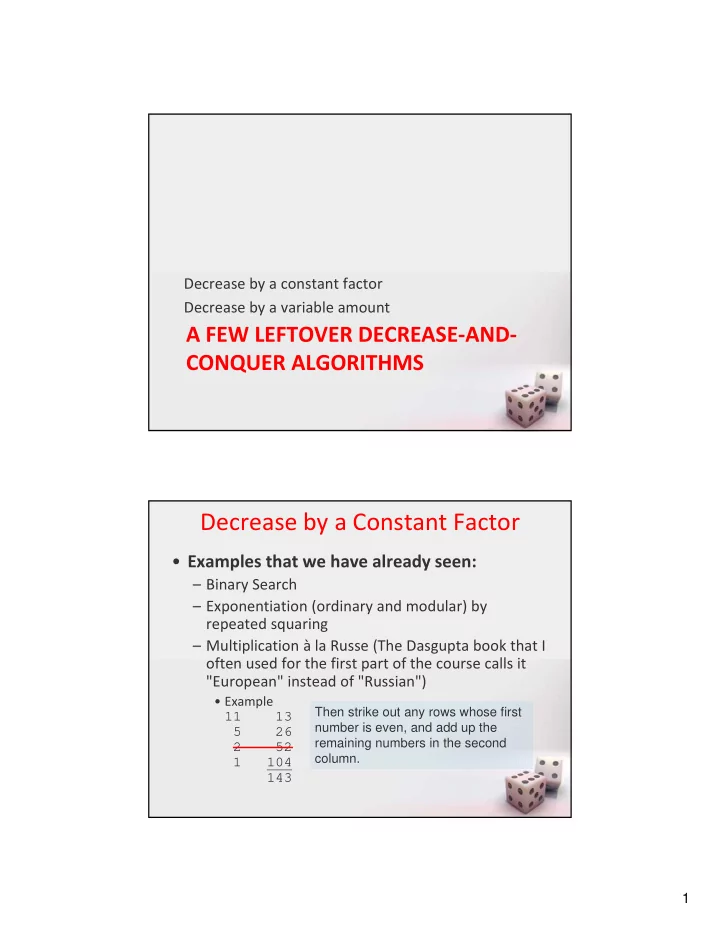

Decrease by a constant factor Decrease by a variable amount A FEW LEFTOVER DECREASE ‐ AND ‐ CONQUER ALGORITHMS Decrease by a Constant Factor • Examples that we have already seen: – Binary Search – Exponentiation (ordinary and modular) by repeated squaring – Multiplication à la Russe (The Dasgupta book that I often used for the first part of the course calls it "European" instead of "Russian") • Example Then strike out any rows whose first 11 13 number is even, and add up the 5 26 remaining numbers in the second 2 52 column. 1 104 143 1
Fake Coin Problem • We have n coins • All but one have the same weight • One is lighter • We have a balance scale with two pans. • All it will tell us is whether the two sides have equal weight, or which side is heavier • What is the minimum number of weighings that will guarantee that we find the fake coin? • Decrease by factor of two? Decrease by a variable amount • Search in a Binary Search Tree • Interpolation Search – See Levitin, pp190 ‐ 191 – Also Weiss, Section 5.6.3 2
Median finding • Find the k th element of an (unordered) list of n elements • Start with quicksort's partition method • Informal analysis One Pile Nim • There is a pile of n chips. Two players take turns by removing from the pile at least 1 and at most m chips. (The number of chips taken can vary from move to move.) • The winner is the player that takes the last chip. • Who wins the game – the player moving first or second, if both players make the best moves possible? • It’s a good idea to analyze this and similar games “backwards”, i.e., starting with n = 0, 1, 2, … 3
Graph of One ‐ Pile Nim with m = 4 6 1 7 2 10 5 0 8 3 9 4 • Vertex numbers indicate n, the number of chips in the pile. The losing position for the player to move are circled. Only winning moves from a winning position are shown. • Generalization: The player moving first wins iff n is not a multiple of 5 (more generally, m+1); – The winning move is to take n mod 5 (n mod (m+1)) chips on every move. Multi ‐ Pile Nim • There are multiple piles of chips. Two players take turns by removing from any single pile at least 1 and at most all of that pile's chips. (The number of chips taken can vary from move to move) • The winner is the player that takes the last chip. • What is the winning strategy for 2 ‐ pile Nim? • For the general case, consider the "Nim sum", x y, which is the integer obtained by bitwise XOR of corresponding bits of two non ‐ negative integers x and y. What is 6 3? 4
Multi ‐ Pile Nim Strategy • Solution by C.L. Bouton: • The first player has a winning strategy iff the nim sum of the "pile counts" is not zero. • Let's prove it. Note that is commutative and associative. • Also note that for any non ‐ negative integer k, k k is zero. Multi ‐ Pile Nim Proof • Notation: – Let x 1 , … ,x n be the sizes of the piles before a move, and y 1 , … ,y n be the sizes of the piles after that move. – Let s = x 1 … x n , and t = y 1 … y n . • Observe: If the chips were removed from pile k, then x i = y i for all i k, and x k > y k . • Lemma 1: t = s x k y k . • Lemma 2: If s = 0, then t 0. • Lemma 3: If s 0, it is possible to make a move such that t=0. [after proof, do an example]. • Proof of the strategy is then a simple induction. (do this one with a partner. Great HW or exam question.) 5
Josephus problem ‐ background • Flavius Josephus was a Jewish general and historian who lived and wrote in the 1 st century AD • Much of what we know about 1 st century life in Israel (and the beginnings of Christianity) before and after the Roman destruction of the Jewish temple in 70 AD comes from his writings • The "Josephus problem" is based on an odd suicide pact that he describes – He and his men stood in a circle and counted off – Every other person (or every third person, accounts vary) was killed – The last person was supposed to kill himself – He must have been the next ‐ to ‐ last person! – When it got down to two people, he persuaded the other person that they should surrender instead • http://en.wikipedia.org/wiki/Josephus 6
Recommend
More recommend